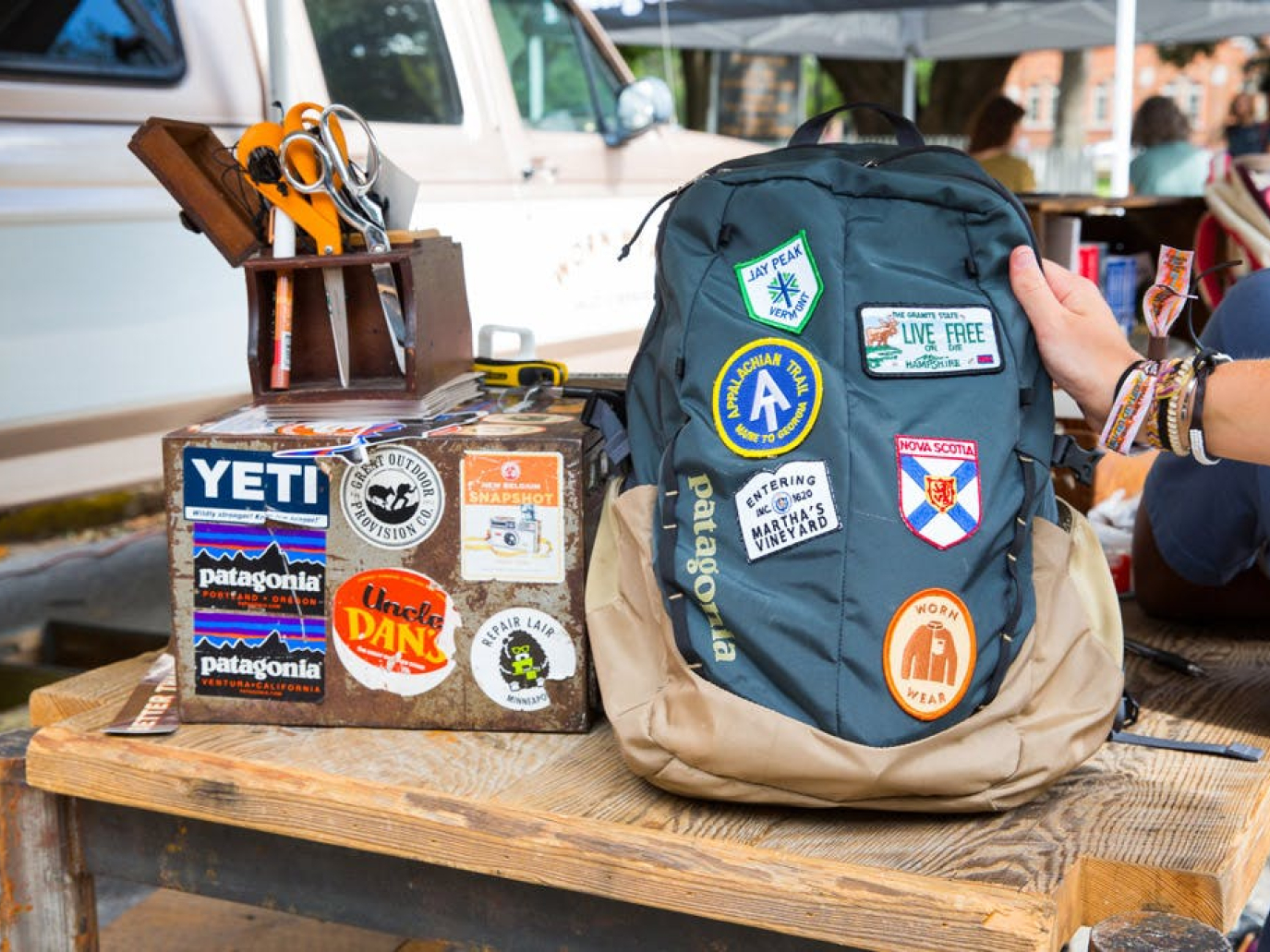If each outdoor enthusiast kept their jacket, pants, base layer, for just one or maybe even two seasons longer, each of these garments would “offset” in that time 1/3 of the production footprint of a new piece of kit. But repair is much more than “just” reduction of carbon footprint. It is a discipline that requires considerable amount of skill, experience, manufacturing and product knowledge – in addition to design vision.
Outdoor gear tells stories. Stories of adventures, successes and mishaps. Stories of travels, friendships, and experiences of a lifetime. The jackets, pants, hats, rucksacks are “partners in crime”. Safeguarding the essentials from tribulations, as well as from the elements, when out and about. Sometimes outdoor kit even saves lives.
Adventures though may sometimes not leave the adventurer unscathed – and certainly not the equipment. And then what? Making away with a damaged piece of outdoor gear is hard. Ridding ourselves of all the memories that are attached to the piece? Nearly impossible. Nostalgia is after all one of the strongest emotions we humans experience. Or so we say.
Durability, Repair, and the Carbon Footprint
But it is not only an emotionally tough decision to get rid of a well-worn and well served piece of outdoor apparel: it is an act of resignation – doing clothing repairs in not a skill that many of us still possess as well as a lesson in humility. Indeed, a decision with a potentially significant financial and environmental cost: the apparel industry emits yearly an estimated 2.1 billion metric tons of greenhouse gases (as at 2018). Knowing that every year also around 80 billion pieces of clothing are being produced globally, we know that each piece of clothing emits at the very least 26.2 kilograms of GHG just until it gets to the consumer. Given that the outdoor industry tends to use more resource intensive (but also better quality) materials, this number is probably a rather conservative estimate.
Interestingly though, and very relevant for an industry producing such durable goods as the outdoor industry, extending the life of clothing by just nine months of active use, or the equivalent of one to two usage seasons, would reduce total carbon emitted, waste, and water footprint, by around 20-30%. In other words, if each outdoor enthusiast kept their jacket, pants, base layer, for just one or maybe even two seasons more, each of these garments would “offset” in that time 1/3 of the production footprint of a new piece of kit. That’s a very significant number for what is just a few meagre months of lifetime extension.
But there is more to this story. Some outdoor kit never makes it to the user in the first place. For a plethora of reasons, the two most dominant possibly being quality issues, and unsold stock. In fact, research shows that 82% of products classified by a brand as waste can be renewed and subsequently (re-)sold.
Ensuring hence that a significant portion of such lightly damaged “seconds” (36% of the total) find their way to a user, would likely safe much larger quantities of carbon, waste, and water. In fact, the data shows that just a small intervention would make such “seconds” “fit for purpose” again: 26% require merely cleaning of some dirt or stains; 21% fixing of a hole; 9% mending of a tear; and 7.5% the replacement of a broken zipper.
With all that said, there is a slow yet steady development going on in the outdoor industry that falls nothing short of a revolution.
Keeping in Use: A Revolution in the Making
Design and use, brand and consumer. Two distinct phases, two distinct players that impact the longevity of a garment. The brand designs for durability, for repairability, and may provide tools, instructions and services to prolong the product’s life time. The users stress tests a piece, leave their adventure marks, and put instructions, tools and services to good use to make their kit last. Two intertwined players no doubt. And yet – it is the brand that needs to take the first step to empower the user to venture beyond their usual equipment comfort zone. Table 1 presents an overview of the types of tools and initiatives by designers and outdoor brands that are leading the quest to make “stuff” last.

Craftspeople at Work: In-House Repair Workshops
In-house repair workshops were probably one of the better kept secret in the outdoor industry. For good reasons: historically, they evolved from a brand’s sampling department, hence the place where the innovative designs and specifications would emerge to the light of the day. Skilled sample machinists were few and far on the market. Sample machinists that were skilled enough to handle the quality level and fabrics used in outdoors, much rarer still. And if anything, these craftspeople have become only more precious in the years gone by.
The secret has been so well kept that while nearly all outdoor brands possess such an in-house pool of expertise, few talked about it in public, and even fewer outdoor users were aware of them. Yet, despite this lack of marketing, the wait for a garment to be returned after repair could take weeks.
This is now slowly changing, and ever more brands are being public about their in-house expertise:
Apparel: Alpkit, Arc’teryx, Bergans of Norway, Berghaus, Fjallraven, Hagloefs, Houdini, Lundhags, Mammut, Orthovox, Patagonia, Picture Organic, Rab, Rotauf, Salewa, Vaude.
Equipment: Alpkit, Exped, Hilleman, Patagonia, Vaude.
Footwear: Aku, Hanwag, Lowa, Lundhags, Meindl.
The repair and sample department is at the same time the first quality feedback loop for a brand. After all, it is here that garments typically return to during their warranty period.
The buck doesn’t stop here though as Patagonia’s Worn Wear truck took this concept one step further: not only did the van bring the repair workshop to the outdoor lover – at festivals, at fairs, at races and competitions. But they also accepted any garment for repair, no matter the brand, while showing live how repairs are being done. Garment repair turned into an exhibition craft.
Helping to Help Themselves: Empower to Repair
In a globalised world though, a brand’s in-house repair workshop will hardly ever be enough to keep the sheer quantities of garments sold in circulation for as long as possible. Even before we consider “details” such as borders or import/export regulations. Some items – particularly knitwear products such as base layers – are even out of scope for the in-house workshops as they require entirely different skills.
Enter thus platforms such as iFixit, the Repair Cafe Movement, and of course Youtube, Vimeo and the like. Paired with the knowledge of passionate outdoor enthusiasts, and some of the most forward-thinking brands and highly skilled designers around, accessible “help for self-help” is finally available: iFixit is a wiki-based site that teaches people how to fix almost anything. Anyone can create a repair manual for a product, and anyone can also edit the existing set of manuals to improve them. The site empowers individuals to share their technical knowledge with the rest of the world. A fact that both Patagonia and VAUDE have used for their purposes by making manuals, but also spare parts, available to the community of mending outdoor enthusiasts.
And then there are brands like Exped or knitwear specialist Collingwood-Norris, who simply skip the intermediary, and make repair instructions available via their websites and social media channels. Again: not only to their own customers, but to anyone who dares to care.
“Learning to darn is an extremely useful life skill when it comes to caring for your clothes,” says Flora Collingwood-Norris, expert in knitwear and visible creative mending at Collingwood-Norris Design. “If a hole can be caught early while it’s small, it stops the damaged area getting bigger and makes a huge difference to the time it takes to repair the garment in the long run. Duplicate stitch (also called ‘swiss darning’) is a particularly useful technique to learn for repairing knitwear such as frequently used base layers. It is well suited to reinforce areas that have worn thin, as well as to repair small holes. The act of mending and caring for your clothes is also very satisfying – and a unique opportunity to express creativity and design preferences in a most unexpected way.”
Even more fascinating, visible repairs, showing explicitly and beautifully that an item has been mended, are becoming not just acceptable, but indeed a way to tell the world about both expert craftsmanship and design skill.
Repairability: Design to Repair
In a landmark move, the European Parliament voted in November 2020 in favour of consumers’ Right to Repair (395 votes in favour, 94 against; 207 abstentions). It sends a clear message: durability and premature obsolescence needs to be tackled at EU level. Without a doubt hence, design for repairability is one of the key innovation areas for brands, including those in the outdoor industry. And by introducing their Repair Index, VAUDE has already pushed ahead with this concept, even before the EU Parliament’s landmark vote. “The Repair Index ensures to our customers that at VAUDE repairability is not a coincidence but embedded into the development process of each individual product” has commented to Renewable Matter Hilke Patzwall, CSR Manager of VAUDE.
However, their Repair Index remains an in-house tool only. Its intent is to provide valuable decision criteria for designers and product managers alike. And to ensure that repairability is not a coincidence, but taken into account in the development of each and every product. As with all sustainability issues, the challenge lies in achieving an optimal balance between functionality, innovation, design, or profitability. And the index is another ingredient in this effort.
Waste Not, Want Not
Customer returns and “seconds” (products with minor quality flaws) are a well known, but hardly spoken about, reality in all consumer goods industries. Outdoor is no exception to this rule.
What came as a surprise to the outdoor apparel industry though was how many of these items could be “fit for purpose” again with only minimum intervention. A clear smack in the face of the currently dominant practice of sending these items directly to incineration or landfill.
The Renewal Workshop in particular has been a pioneer in offering a solution, as well as proofing the business case: by combining “renewal”, i.e. the fixing of all those small things in need of repair, and an e-commerce outreach to find those goods their first ever owner.
Their business case has proven to be water tight, resulting in a broad range of collaborating brands on the one hand, and the addition of a 2nd “renewal” Amsterdam unit in Spring 2020, offering the service also to the European market. Amongst their collaborating brands, household names such as The North Face (with North Face Renewed), Eagle Creek, Osprey or Pearl iZUMi can be found.
Indeed, the data keeps proving their case: at the time of writing just over 150,000 kilograms of goods had already been diverted from landfill. A not insignificant number for what is still a very young company with a fairly small staff base, but a big and compelling vision.
Download and read the Renewable Matter issue #35 about outdoor sector.



